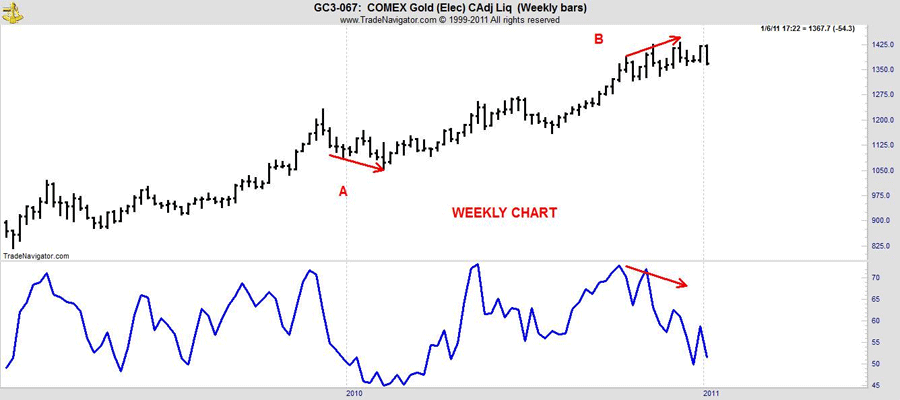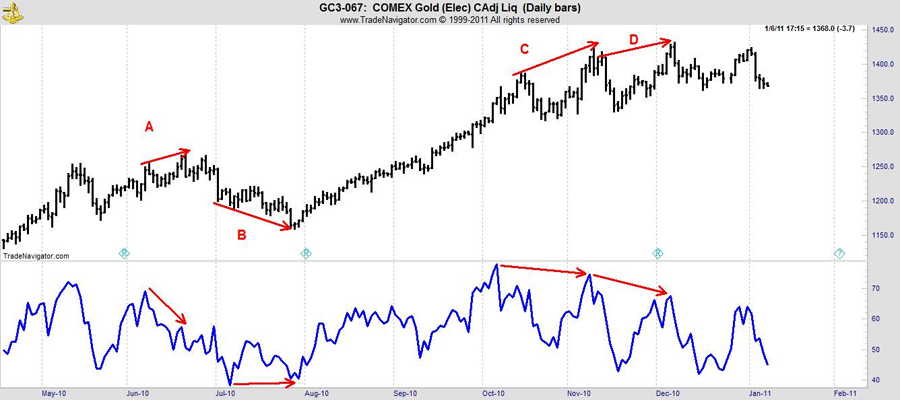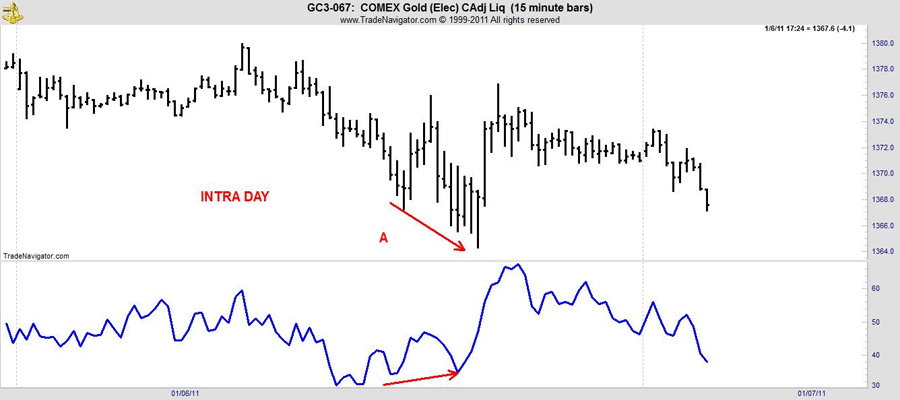I developed this trading and investing indicator in 1976. All oscillators essentially tell us the same thing; how price has performed over a specific time. This indicator is unique in that it combines three time periods, short, intermediate and long-term into one oscillator. Thus it has fewer false divergences and signals than a traditional one-time period oscillator. It is a stock or futures trading indicator that can be used in any time frame: short term trading, day trading, swing trading, long term trading, investing, intra-day trading, investing, etc – any trading time frame for futures, stocks, or commodities.
Let’s start at the beginning.
There is nothing more intriguing to the beginning commodity or stock trader than the discovery of oscillators. At first, oscillators appear to be the perfect stock or commodity trading tool because so often they give excellent buy and sell signals. But, the more you use oscillators, the more you realize that oscillators give an equal number of false signals.
Since 1900, stock and commodity traders have tried to tame their oscillators in order to develop a new approach that does not give false signals or false divergences yet provides an insight into the market that no other tool can.
An oscillator actually measures the momentum of data, whether it is price, volume, or open interest. An oscillator will help show the speed at which the information is changing. Thus, it can also define over-bought or over-sold areas.
The pioneer in oscillator work was Owen Taylor who in the 1920’s presented oscillator work based on 7-day data. Taylor looked at price today versus a 7-day moving average of price or a 7-day moving average of advancing and declining stocks over the last seven days.
In the 1940’s Woods and Vignolia started their interesting approach to the market measuring volume in what is now known as On Balance Volume. These two gentlemen, based in San Francisco, started running a cumulative positive-negative volume flow that was later popularized by Joe Granville. Woods and Vignolia also did a tremendous amount of oscillator work using 20 to 40-day measurements of days that had up volume versus days that had down volume.
Slightly earlier than this, the Lowry Reports out of Florida were busy running moving averages on advancing and declining stock or advancing and declining volume under their heading of “buying pressure” and “selling pressure”.
In the 1950’s not too much was done in the way of oscillators. It wasn’t until 1960 that Security Market Research, a service out of Denver, Colorado, showed an oscillator based on the difference between two moving averages that the oscillator number crunchers started getting busy again.
The ability to construct oscillators improved substantially with the advent of the computer and especially small personal computers. That allowed the introduction of a new approach to oscillators going beyond a simple moving average. The new trading crowd had been to college, had studied their math, and was suddenly flipping around words like exponentials, supersonic averages, front-end-weighted moving averages, lagged moving averages, rolling numbers, etc.
This all reached its zenith in what has become one of the most widely known oscillators constructed by Wells Wilder: the Relative Strength Index. In fact the index is not a measure of relative strength because “relative” means “in relation to something.” What Wilder created was an oscillator based on a 14 day time cycle, an oscillator that has a decent record of giving buy and sell signals in the market.
The Oscillator Opportunity
The reason people have continued dabbling with oscillators is that they have the capability to give indications in advance of market turning points. I wrote an article in 1973 for what was then known as Commodities magazine (now Futures Magazine) that showed an approach to oscillators in the pork belly and soybean oil market that actually led major tops and bottoms in the market.
The trouble for most oscillator workers was, and has continued to be, that while frequently oscillators lead, sometimes they lead far too early and instead of buying a bottom, you are buying falling daggers and getting sliced up. Even the best oscillators consistently give premature buy and sell signals. I believe my “Ultimate Oscillator” corrects this.
The Oscillator Problem
The largest failure of oscillators is their inability to deal correctly with the time cycles involved. Let me explain that a bit. If you use a 7-day average, as Taylor did in the 1920’s, you will quickly find that the maximum move you are going to catch is one that lasts somewhere in the area of 3 1/2 to 9 days. In other words, the type of moves the oscillator catches cannot, by definition, be much longer than the time period measured in the oscillator.
If you go out to a longer term approach—something that measures what is taking place in sixty or seventy days—the problem is that by the time your oscillator’s identified the trend, the trend then reverses. Markets are so quick that anything using 30, 50, or 80 days does not respond quickly enough to get you in and out with profit.
One thing I noticed through the years is that the traditional short term oscillators, such as those featured in most trading and investing books, will turn very positive at the start of a major upmove in the market but quickly show divergence and overbought readings, causing most traders to sell short somewhere after the first leg of a bull market. They then take a short position on the market and hold that short position in one form or another, actual outright short or afraid to purchase, for the next three or four legs of the bull market. That can be a costly experience. This happens because the time measurements in the oscillators they are following are too short-term in nature to catch a major move.
All About the Ultimate Oscillator
What is really needed is an oscillator that expands as the market gets stronger or weaker. As an example, if the market shows a tremendous amount of strength your oscillator would expand the time base, thereby not allowing the short term fluctuation to influence the fact that the market has turned the corner on a long-term basis.
To capture this effect, I have included in the ultimate oscillator three different time cycles in the marketplace. Additionally, instead of measuring price, I believe it is more profitable to measure the amount of accumulation and distribution taking place in the market.
It Is About Time
Time is one of the most critical elements in creating your oscillator. I have chosen three different time periods for the oscillator, three time cycles that generally have been the most dominant time cycles in the market. I use one which is based on 7, 14 and 28-day measurements of accumulation and distribution. I have found that those time periods are generally the ones that give the moves most traders wish to trade.
The Great Equalizer
One needs to equalize these time periods. To do this, we will multiply the data we get from the seven day time series by 4 and multiply the data arrived at from the 14 day time period by 2, thus having equal values for all three cycles.
Measuring Accumulation and Distribution
I have tried to measure accumulation and distribution in commodities in terms of volume, in terms of open interest and in terms of net change, in terms of volatility factors, in terms of tick by tick trade, you name it. The bottom line of all that effort is that what appears to be the easiest way of measuring accumulation and distribution is to simply define selling pressure as the price movement from the high to the close each day while taking the buying measurement to be the difference between the low and the close.
For this study, one must also incorporate the previous day’s closing price if the following day’s high is lower than the previous day’s closing price or the following day’s low is higher than the closing price. In short, then one must fill in the gaps that occur between yesterday’s price and today’s high or low. As an example, if yesterday’s closing price was 60 and this morning’s low was 61 with a close today of 63, the measure of buying would not be 63 minus 61 but 63 minus 60 or 3 cents of buying.
Constructing the Oscillator
You need to set up several columns. First, I always post the high, low, and close each day. In one column to the right I have the buying units for that day, defined as the close minus the true low. I then skip a couple of columns and have another column to record the total activity of the day. We would define that by subtracting the true high from the true low. We have then created on a daily basis the amount of buying for the day and the total amount of activity (buying and selling) for the day.
I next run a 7-day sum of the total amount of buying for the last seven days. I also run a 14-day sum of the buying figure and finally a 28-day sum. I then do the same thing with the total activity or range figure by running 7, 14, and 28-day sums of the range.
Now the fun begins. I then divide the 7-day figure of the range into the 7-day figure of buying, giving the percent of buying in that time period. I next divide the total range of the 14 days into the buying of the 14 days to give me a percent of buying for the 14 days. I follow up with the third step of dividing the total range for the last 28 days into the total buying for the 28 days, giving me a percentage of buying during that time period. Finally I multiply the 7 day figure by 4 and the 14-day figure by 2 to equalize the impact that each time period will have.
If you have followed along with me so far, you now realize that I add the final 7, 14, and 28-day figures into one master percentage figure that reflects the buying pressures and, concomitantly, the selling, of three time periods over the last 28 days, all equalized to give each time period an equal impact. This data is then plotted as a percentage change underneath price action resulting in the Ultimate Oscillator.
Rules for Using the Ultimate Oscillator
There will be two requirements for a buy and sell signal to activate a market position using the oscillator. Our first demand is that we have a price divergence from the oscillator. In the case of a buy we must have had a lower low in price that was not matched by a lower low in the oscillator. In the case of a sell we must have had a higher high in price that was not matched by the oscillator. Secondly, await a trend break in the Ultimate Oscillator to produce the actual signal.
As you can see in our weekly chart of Gold below, for example A there is no divergence between the Ultimate Oscillator (the line in blue) and price. However, in example B, there is divergence between the Ultimate Oscillator and price, i.e. price increased while the oscillator decreased.

Ultimate Oscillator Gold Weekly Bars
Once the divergence for a sell signal has occurred, note the low in the oscillator prior to the peak that set up the divergence. Once the Ultimate Oscillator falls below this low, you can take a short position in the market. The failure in the oscillator is your indication that it is time to sell. Frequently you will see this taking place right at or very close to the actual high in price.

Ultimate Oscillator Gold Daily Bars
After the divergence for a buy signal has occurred note the high in the oscillator prior to the low that set up the divergence. Once the Ultimate Oscillator rises above this peak you take a long position. The trend break in the oscillator is your indication that buyers now dominate and an up move will begin. Again, note how close this trend break to the upside occurs in the daily price lows.

Example of Ultimate Oscillator on Gold Intra-Day 15 Minute Bars
Once you have entered a position, you will exit in one of the three following manners:
If Short:
- Exit on an opposite signal occurring. You would also be reversing to the long side.
- Go flat, not reversing, when the Ultimate Oscillator falls to 30% or less. This signal will be early at times but its usage will greatly increase your percent of winners and reduce your number of sleepless nights.
- Once short, close our your position by going flat any time the index rises above 65%,. This is your initial stop loss.
If Long:
- Exit on an opposite signal occurring. You would also be reversing to the short side.
- Go flat, not reversing, when the Ultimate Oscillator rises above 70%. Comments in #2 above apply.
- Once long, close out your position going flat any time the index falls below 45% after having risen above 50%. This is your stop loss.
All divergence signals must first have seen the index rise above 50% for sell and fallen below 30% for a buy. Divergent patterns that occur without the index first going to these levels are not to be acted upon.
